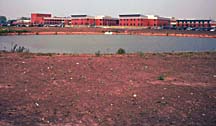
Or, maybe you’ve heard that because GHP systems have relatively few moving parts, and because those parts are sheltered inside a building, they are durable and therefore reliable. The underground piping often carries warranties of 25 to 50 years, and the GHPs often last 20 years or more.
However, even the best laid plans sometimes go awry. A GHP system may not work as originally intended. What do you do if that happens?
Fortunately, troubleshooting a GHP is straightforward, as is the regular maintenance required by these systems.

Minimal Service
Low maintenance is one of the big benefits of GHPs. According to a study completed for the Geothermal Heat Pump Consortium (GHPC), buildings with GHP systems had average total maintenance costs ranging from 6 to 11 cents per square foot, or about one-third that of conventional systems.The piping is the workhorse part of the system. Because it is underground or underwater, little maintenance is required. Occasional cleaning of the heat exchanger coils and regular changing of air filters are about all that is necessary to keep the system in good running order. (See sidebar below.)
Wayne Eigenrauch is the technical support manager for Enertech, Inc., Greenville, Ill. He agrees that servicing these systems is fairly easy. “You do your normal routine maintenance that you would do for any type of heating and cooling system. Basically, just keep the air filter clean and make sure the condensate pan is clean. It’s also necessary to check the geothermal loop pressure.”
Enertech is a distributor that specializes in geothermal heating and cooling. In addition to “GeoComfort” products, the company distributes in-floor radiant products and provides regular training to contractors on how to install, service, and troubleshoot GHP systems.
Eigenrauch is one of the trainers. He says that contractors new to the world of geo-thermal systems are often intimidated by them. But, he says, there’s really no reason to be afraid of these systems.
“The first thing we do with a new contractor is get them in touch with a loop contractor that will install the loop, flush it out, and get everything done for the contractor. The contractor needs to just basically set the machine, run the ductwork, and do what they’re used to doing. As things evolve, we will get the contractor into installing a portion of the loop piping. But they need to get their feet wet first,” says Eigenrauch.
It may take as little as five or as many as 20 installations before a contractor truly feels comfortable installing a geothermal system on his own.

When Trouble Sets In
When there is a problem with a geothermal system, it makes sense to look at all of its parts. Eigenrauch notes that the refrigerant circuit should be the last part contractors look at, because it’s factory assembled and sealed. “Typically it’s not the refrigerant circuit giving you a problem,” he explains. “Always look at all other avenues first before putting the gauges on the machine.”Water problems can be a source of trouble in open-loop systems that use conventional well water. “You need to have very clean, clear water, and even in areas of the country with pretty decent water, you are going to end up with mineral deposits and some of the water biology type of deposits,” says Leo Udee, trade account manager, Alliant Energy Geothermal Information Office, Fond du Lac, Wis.
If trouble is identified early, then the technician has the opportunity to clean the problem area. However, Udee notes that most people don’t take the time to open up the water side of a system. The reason is that the geothermal system is really two different entities.
“There’s the loop component and the heat pump component,” Udee says. “A mechanical technician may look at the heat pump component but not bother to look at the water side of the system, which may need to be checked by a plumbing technician. That usually means any water chemistry problems go unnoticed until a serious issue develops.”
Another regular culprit for improperly performing GHP systems is the ductwork. Udee says common duct problems include:
Correcting these issues can be time consuming and/or costly, so it’s best to make sure the ductwork was designed correctly to begin with.
Udee adds that occasionally a GHP system has component failures, and sometimes the customer understands neither what a GHP system does nor how it should perform. “This can mean there are operator errors,” says Udee. “A few problems can be caused by the building envelope, so a thorough analysis of the building’s thermal qualities and air infiltration is important.
“Proper GHP system sizing is more of a science and is not a guessing game, so a ‘holistic’ approach needs to be taken when assessing the building.”
Udee described a brand new house with a geothermal system in the Northwest. The homeowners had a problem: The geothermal system could barely maintain either the forced-air system or the in-floor system — it could not support both systems at the same time, as originally designed.
“The contractor came in and did a thorough energy audit, including a blower door test and an infrared scan. It really opened some eyes, because it wasn’t the geothermal system at all. It was the structure, which was very leaky. It took a long time, but they sealed up the ductwork, as well as other envelope leaks, and now everything works fine.”
Sidebar: Regular Maintenance – The Key To System Longevity
According to the Alliant Energy Geothermal Information Office, the following periodic maintenance procedures should be performed on a GHP system at the intervals indicated:The refrigerant cycle should be serviced by a competent technician, preferably one who is factory trained by the manufacturer.
In all cases, refer to the manufacturer’s operating and maintenance instructions. This information should remain with the equipment owner or operator. For more detailed information, consult the manufacturer’s service instructions.
— Joanna Turpin
Publication date: 08/25/2003


Report Abusive Comment